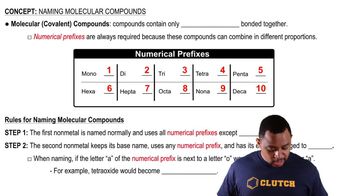Here are the essential concepts you must grasp in order to answer the question correctly.
Ionic Compounds
Ionic compounds are formed when atoms transfer electrons, resulting in the formation of charged ions. Typically, this occurs between metals and nonmetals, where metals lose electrons to become positively charged cations, and nonmetals gain electrons to become negatively charged anions. The electrostatic attraction between these oppositely charged ions leads to the formation of a stable ionic lattice structure.
Recommended video:
Molecular Compounds
Molecular compounds consist of molecules formed by covalent bonds, where atoms share electrons rather than transferring them. These compounds usually form between nonmetals and can exist in various states (solid, liquid, gas) at room temperature. The properties of molecular compounds, such as lower melting and boiling points compared to ionic compounds, are influenced by the strength of the covalent bonds and the intermolecular forces present.
Recommended video:
Naming Molecular Compounds
Electronegativity
Electronegativity is a measure of an atom's ability to attract and hold onto electrons in a chemical bond. In the context of ionic and molecular compounds, a significant difference in electronegativity between two atoms typically indicates that an ionic bond will form, while a smaller difference suggests the formation of a covalent bond. Understanding electronegativity helps predict the nature of the bond and the resulting classification of the compound.
Recommended video:
 Verified step by step guidance
Verified step by step guidance


